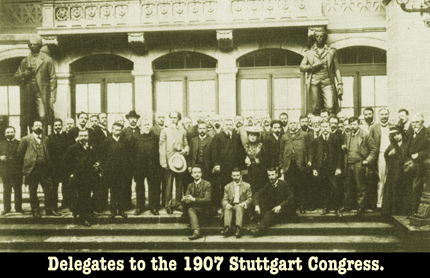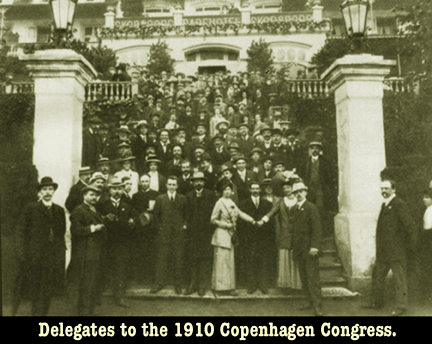
Planning for a second international association of socialist parties began in April 1888, when the leadership of the German Social Democratic Labor Party began to consider the possibility of holding a joint gathering with representatives of the powerful French labor movement. The centennial of the French Revolution of 1789 was considered a provocative tie-in for the event and doubtlessly helped to spur the process forward. The October 1888 Congress of the French Federation of Syndicates and December 1888 Congress of French socialist organizations decided to help prepare an international workers' congress in 1889, and in January of 1889 the National Socialist Commission, which included the French Workers' Party and the Blanquists, decided to invite all workers' organizations to a 1889 congress.
On Feb. 28, 1889, a conference took place in The Hague, Holland, at the suggestion of Wilhelm Liebknecht, bringing together representatives of the workers' organizations of Germany, France, Switzerland, Holland, and Belgium to discuss preparations for a founding congress in September of 1889. This gathering was boycotted by the French Federation of Socialist Workers ("Possibilists"), a Right trend concentrated in the union movement, which sought to hold a congress of its own in which it would have a place of organizational hegemony. This group planned for a congress of their own, to begin July 14, 1889, in Paris. The decision of the Liebknecht-inspired group was changed to likewise hold its founding congress on that significant date.
The Organizing Committee for the Liebknecht-inspired congress and the French Possibilists refused to negotiate with one another and so two competing congresses were held.
The "Congress of United Socialists" was convened at 9 am at the Salle Petrelle in Paris. At its convocation, there were 384 delegates from 20 countries, holding some 393 mandates and representing about 300 labor and socialist organizations. The total number of participants grew over the course of the gathering, reaching a total of 407 on July 17 and increasing somewhat even after that. The French delegation was largest, counting some 206 delegates with 211 mandates, the greatest number of whom were Marxists or Blanquists working together under the leadership of Paul Lafargue and Eduard Valliant. Some 81 delegates represented the German socialist and labor movement, while England was represented by a delegation of 19, including such figures as William Morris, Eleanor Marx-Aveling, and James Keir Hardie. The Russian revolutionary movement was represented by 6 delegates, including Georgii Plekhanov. The United States was represented by a delegate of the Socialist Labor Party of America.


The Second International convened a joint Congress with the Vienna International in Hamburg, Germany, beginning on May 21, 1923. This congress was attended by 620 delegates representing 41 parties of all non-Communist tendencies. The meeting established a new united Socialist International, called the Labor and Socialist International. The manifesto of the Hamburg Congress laid down no conditions for admission and formulated no specific program.

